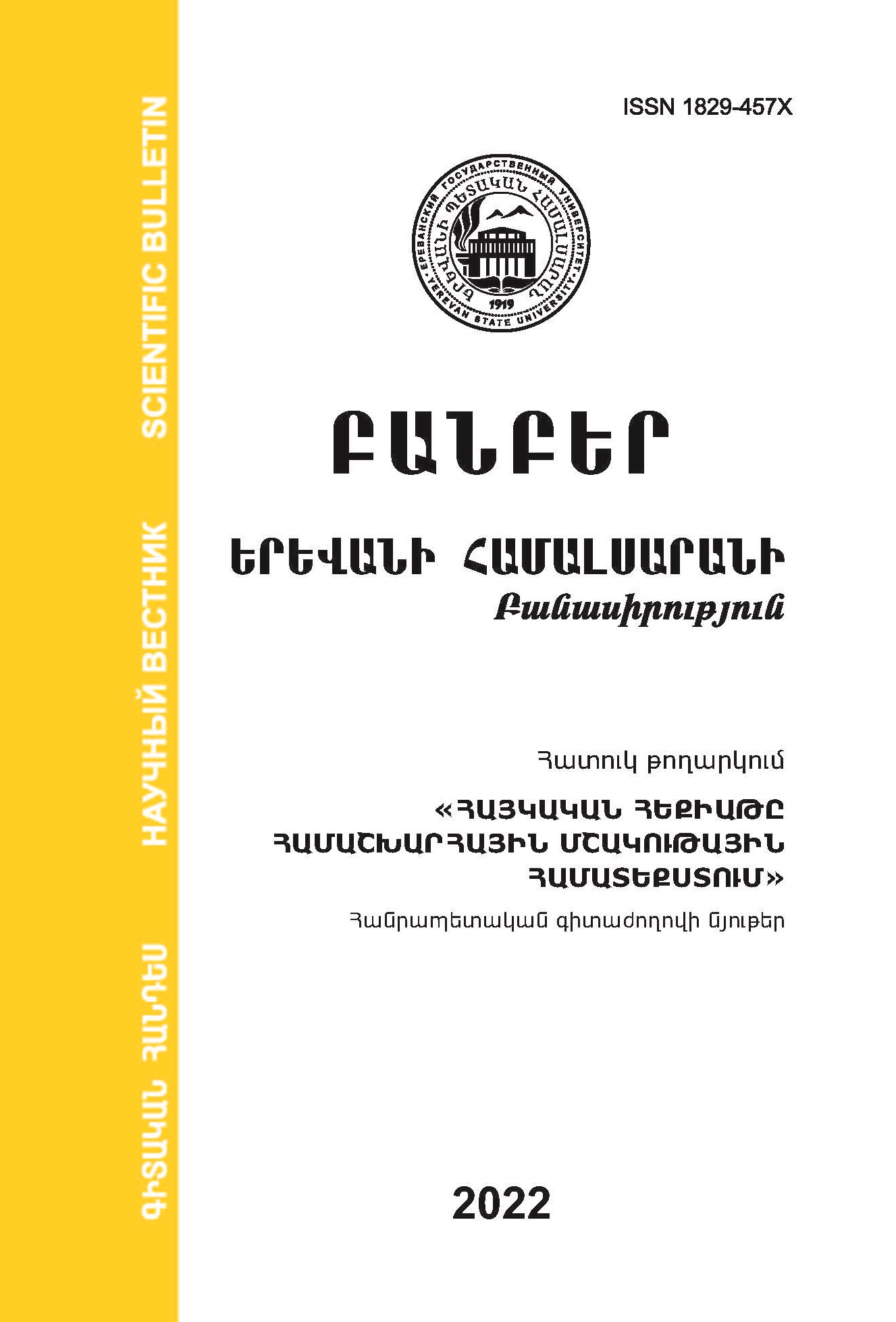The Symbolism of Garden in Armenian Folktales
DOI:
https://doi.org/10.46991/BYSU:B/2022.sp1.013Keywords:
Fairy tale, garden, Paradise, sin, loss, singing birdAbstract
In the rich landscape of a fairy tale, a special place is occupied by the garden as an ideal human habitat - bright, blooming, fertile, with which the motives of love, union, marriage, growth and fertility are associated in the fairy tale.
The article deals with the main motives of the fairy tale associated with the garden - their various manifestations - from the paradise garden of immortality to ordinary earthly gardens. The garden is presented as an ideal habitat given to man by God, the misuse of which in some cases leads to the motives for the loss of the garden. The article considers some literary adaptations of these folklore motifs in Armenian and world literature (H.Tumanyan, H.Ch. Andersen, O.Wilde).
An attempt is made to clarify the symbolism of the garden in the plots under consideration, to study the problem of the connection between the garden and the singing bird in the context of the semantics of the unity of soul and body.
References
Մ. Աբեղյան, Երկեր, հ. 1, Եր., 1966:
В.Н. Топоров, Модель мира (мифопеэтическая), Мифи народов мира, Советская
энциклопедия, М., т. 2, 1992.
Ն. Վարդանյան, Սահմանային գոտու սիմվոլիկան հրաշապատում հեքիաթում, «Ոսկե դիվան»,
հեքիաթագիտական հանդես, պրակ 4, 2012-2013, էջ 46-53:
Հ. Պետրոսյան, Հայ միջնադարյան պատկերացումները իդեալական կենսատարածքի եւ կենսընթացի մասին.
Աշխարհը որպես այգի // Հանդէս ամսօրեայ, Վիեննա-Երեւան, 2002, թիվ 1-12, էջ 411-440;
«Сад: Символы, метафоры, аллегории, М., «Памятники исторической мысли»,
Հայ ժողովրդական հեքիաթներ, հ. 1, Եր., 1959:
Հայ ժողովրդական հեքիաթներ, հ. 2, Եր., 1959:
Հայ ժողովրդական հեքիաթներ, հ. 3, Եր., 1962:
Հայ ժողովրդական հեքիաթներ, հ. 4, Եր., 1963:
Հայ ժողովրդական հեքիաթներ, հ. 5, Եր., 1966:
Հայ ժողովրդական հեքիաթներ, հ. 6, Եր., 1973:
Հայ ժողովրդական հեքիաթներ, հ. 15, Եր., 1998:
Ռ. Գրիգորյան, Գեղարքունիք, «Հայ ազգագրություն և բանահյուսություն», հ. 14, Եր., 1983:
Ե. Լալայան, Երկեր, հ. Գ, Եր., 2004թ.:
Ջ.Ֆրեզեր, Ոսկե ճյուղը. մոգության և կրոնի ուսումնասիրություն, Եր., 1989:
Ն. Վարդանյան, Եդեմի, դրախտի պարտեզի և այգու այլաբանությունը հայ ժողովրդական քնարերգության
մեջ, «Էջմիածին», Մայիս 2021, էջ 79-91:
Ն. Վարդանյան, Քունը հեքիաթի կառուցվածքային շղթայում // «Քունը և երազը հեքիաթում»,
Գիտաժողովի ծրագիր և թեզիսներ, Հովհ.Թումանյանի թանգարան, Եր., 2015, էջ 20-21:
Սասունցի Դավիթ, Եր., 1961:
Հ. Թումանյան, Երկերի լիակատար ժողովածու, հ. 4, Եր., 1991:
Վ. Դևրիկյան, Հազարան բլբուլի Թումանյանի մշակումը հեքիաթի տարբերակների համատեքստում //
«Ոսկե դիվան», հեքիաթագիտական հանդես, պրակ 6, Եր., 2018-2019:
Андерсен Х.К., Сказки рассказанные детям (узд. Подготовили Л.Ю.Брауде и
И.П.Стреблова), Москва, 1983.
Հ.Աճառյան, Հայերեն արմատական բառարան, հ. 1, ԵՊՀ հրատ., Երևան, 1926:
Գ.Սրվանձտյանց, Երկեր, հ. 1, Եր., 1978թ.:
Օսկար Ուայլդ, Երկեր, Եր., 1980:
Հ. Թումանյան, Երկերի լիակատար ժողովածու, հ. 9, Եր., 1997:
«Հայոց հին և միջնադարյան բանաստեղծության քրեստոմատիա», կազմ.՝ Ա. Գ. Մադոյան, Գ. Գ. Անանյան,
Եր., 1979:
Ժ. Քալանթարյան, Հայ գրականագիտության պատմություն, Եր., 1986:
Ղ. Ալիշան, Հայոց երգք ռամկականք, Վենետիկ, ս.Ղազար, 1852, էջ:
Ա. Մնացականյան, Հայկական միջնադարյան ժողովրդական երգեր (խմբ.` Շ. Նազարյան, Էմ. Պիվազյան),
Եր. 1956:
Downloads
Published
How to Cite
Issue
Section
License
Copyright (c) 2022 Bulletin of Yerevan University

This work is licensed under a Creative Commons Attribution-NonCommercial 4.0 International License.

